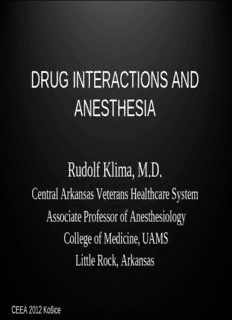
drug interactions and anesthesia PDF
Preview drug interactions and anesthesia
DRUG INTERACTIONS AND ANESTHESIA Rudolf Klima, M.D. Central Arkansas Veterans Healthcare System Associate Professor of Anesthesiology College of Medicine, UAMS Little Rock, Arkansas CEEA 2012 Košice OBJECTIVES Introduction Pharmacokinetic interactions Pharmacodynamic interactions In Vitro Interactions Selected groups of drugs and their interactions SIMPLYFIED BASIC TERMINOLOGY Pharmacology - study of how chemical agents affect living processes Pharmacokinetics - what the body does to the drug (absorption, distribution and elimination) Pharmacodynamics - what the drug does to the body (dose – response relationship) PHARMACOLOGICAL (DRUG – DRUG) INTERACTION A drug interaction occurs when a drug interferes in a negative or positive way with another drug PHARMACOKINETIC INTERACTIONS ♦ Pharmacokinetic interactions are mainly due to alteration of absorption, distribution, metabolism, or excretion drug which changes the amount and duration of a drug's availability at receptor sites ♦ Pharmacokinetic interactions are more complicated and difficult to predict because the interacting drugs often have unrelated actions RATE OF ABSORPTION AND ELIMINATION First order kinetics - constant fraction of the drug present will be absorbed or eliminated in a unit of time Half-life t1/2 - time required for 50% of drug to be absorbed or eliminated Elimination rate constant (k ) - the fraction of drug absorbed e or eliminated per unit time Zero order kinetics - processes in which a constant amount of drug is absorbed or eliminated per unit time PHARMACOKINETIC CURVE Cmax: Maximum concentration – may relate to some side effects 10000 AUC: Area under the curve (filled n o area) = overall drug exposure ti 3000 a r t n e c 1000 n o C Cmin: minimum or a trough concentrations: m may relate with efficacy s a of drug l P 100 0 2 4 6 8 10 12 Time Post-dose (hr.) http://www.thebody.com/content/art875.html Pharmacokinetic Interactions DRUG ABSORPTION Absorption from gastrointestinal tract: A/ Nonspecific interactions affecting peristalsis and perfusion (opioids, vagolytics, vasopressors) B/ Physicochemical interactions ■ Chelation (ciprofloxacin + 2- and 3-valent cations) ■ Adsorption (activated charcoal) ■ Cation-exchange (sodium polystyrene sulfonate) C/ P-glycoprotein induction or inhibition
Description: